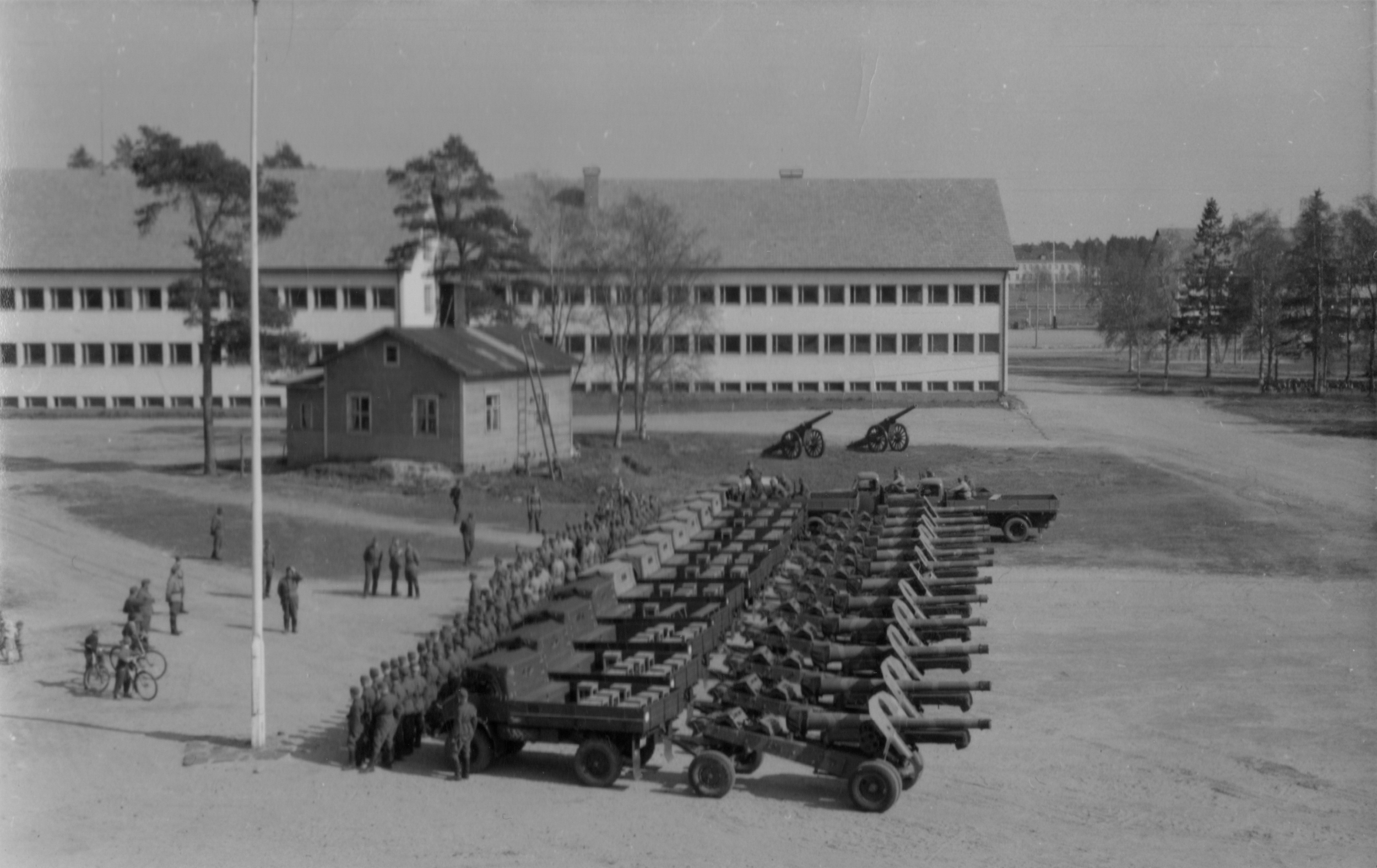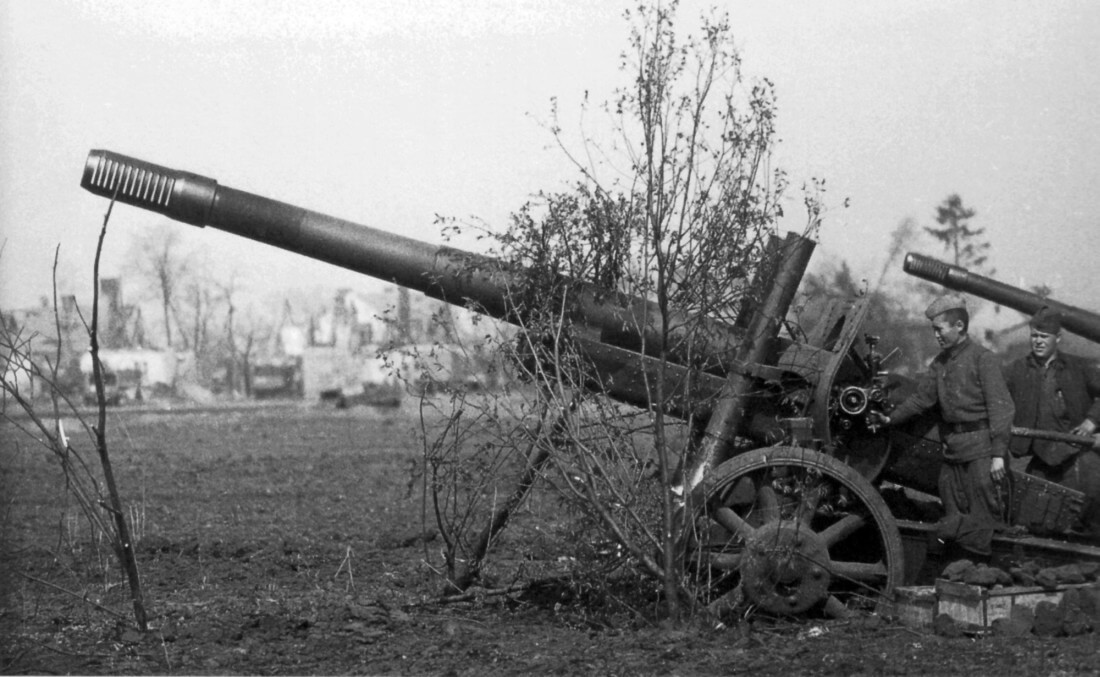The Book of Armaments:
Soviet 152mm Howitzers, Part Two
by Mike Bennighof, Ph.D.
June 2021
 Unable to design a new heavy howitzer from their own resources, in 1931 the Red Army’s Artillery Directorate again turned to the German firm of Rheinmetall, under the secret agreement between the Soviet Union and the Weimar Republic to provide technical assistance in exchange for the ability to build and test new weapons at secret Soviet proving grounds. Unable to design a new heavy howitzer from their own resources, in 1931 the Red Army’s Artillery Directorate again turned to the German firm of Rheinmetall, under the secret agreement between the Soviet Union and the Weimar Republic to provide technical assistance in exchange for the ability to build and test new weapons at secret Soviet proving grounds.
The 152mm NG howitzer design provided by the German firm seemed to meet all Soviet requirements. It had outstanding range and accuracy, and the Artillery Directorate ordered it into production at Plant No. 172 in Perm. And then the troubles began. The Soviet plant proved unable to begin mass production of the howitzer, and could not grasp the technical nuances of the 20mm and 37mm anti-aircraft guns whose plans had been purchased at the same time, nor could they build the 122mm Model 1934 Lubok howitzer designed in the Soviet Union with a great deal of German technical assistance. Only nine 152mm NG howitzers were completed before the project was abandoned; all of them apparently failed their acceptance tests.
The experience of trying to decipher the German designs, and simplify their concepts so the weapons could be produced by semi-skilled Soviet workers laboring in ill-equipped factories, helped birth a new generation of Soviet weapons designers by the mid-1930’s. These young men, none of them past their own mid-30’s, did not bear the political stain of a Tsarist education or work experience. They believed in the Soviet cause, and poured their energy and creativity into crafting weapons to defend the Leninist dream.
Following the production fiascos surrounding the German weapon designs, the Second Five-Year Plan decreed that the new generation of heavy weapons would be built in Soviet factories to Soviet designs. The design bureaus, attached directly to the factories that would be asked to build the weapons they drafted, were considered to have the best understanding of what was possible on the factory floor.
Plant No. 172’s design bureau attempted to use technology scavenged from the failed 152mm NG howitzer to craft a modernized version of the Model 1909, but the Artillery Directorate ordered the work to stop. Instead, the young engineers were told to present a new weapon. Under the leadership of 35-year-old Fedor Petrov, they brought forward two designs.

A Finnish battalion equipped with a dozen 152mm Model 1938 medium howitzers.
The M10 divisional howitzer offered good range and accuracy, but was a very large weapon at over five tons. The prototype did not survive testing, but Petrov made improvements and the Artillery Directorate accepted the howitzer as the Model 1938, with an order to begin serial production placed before the second round of tests had been completed.
When first introduced to the Red Army, Petrov’s howitzer was considered an enormous success. Despite its weight it was very mobile, thanks to an excellent suspension, and could actually be drawn by horses and trucks, though not very well. It had very good traverse and though it did not have a dedicated armor-piercing round, the enormous blast of its concrete-piercing shells was sufficient to vaporize every German panzer in service in 1941. It had no muzzle brake, which increased its recoil; as a divisional howitzer it would be used close to the front where the dust cloud usually raised by a muzzle brake could prove deadly. A shortened version of the howitzer (no longer by definition a howitzer due to its lack of elevation) also armed the KV-2 artillery support tank.
On 22 June 1941 the Red Army had 1,058 of the big howitzers, with 771 of these in the western military districts. Almost all were lost in the opening months of the Great Patriotic War, and new tables of organization abolished the howitzer regiments of rifle divisions and the corps artillery regiments. With no need for the expensive and hard to manufacture weapon, production ceased in September 1941. The Germans captured several hundred and eagerly re-issued them to favored units like the Panzer Lehr Division.
The second weapon proposed by Petrov’s team in 1937, the ML-20 gun-howitzer, proved even more successful. Initially intended for army-level and RVGK (Supreme Command Artillery Reserve) battalions, the ML-20 like other gun-howitzers had the long barrel of a cannon, but the high elevation of a howitzer, which allowed direct fire at high velocity and also greatly increased the gun’s range. It also made the gun far too large and heavy for use as a divisional weapon; it required a new prime mover, the Voroshilovets tractor, and was intended from the start for the RVGK reserve.

The 152mm ML-20 gun-howitzer shows off its mighty barrel.
Production began in 1937. The Red Army had 2,603 of them on hand in June 1941, and it continued in production until 1956. Most of them began the war in corps artillery regiments, and when those were abolished in the summer of 1941 they transitioned to their intended role in army and RVGK formations. A handful also saw use as Navy-crewed coastal artillery.
A variation of the Model 1937, the ML-20S, armed the SU152 and JSU152 assault guns. The barrel was shortened, and the sights and controls re-arranged. Most production shifted to the self-propelled version starting in 1943; 670 of the SU152 (based on the KV1 heavy tank) and 3242 of the JSU152 (based on the JS1 heavy tank) were built; 6,869 of the gun-howitzer version came off the assembly lines by the end of the Great Patriotic War.
With the M-10 (Model 1938) divisional howitzer having fallen out of production in favor of more urgently needed weapons, Petrov took some time to study its flaws and draft a replacement design. The M-10 had been too heavy and consumed far too much in the way of strategic materials in its construction. Petrov sought to correct both of those problems, and also design a weapon that could go quickly into production using existing facilities. Therefore, it needed to use as many components of other artillery pieces already in production as possible.
In February 1943, Petrov presented an outline of his project to the People’s Commissar for Armaments, and in April he received authorization for a preliminary production run of five prototypes, to be built at the newly-established Plant No. 9 in the Urals, which hosted workers and machinery from several factories evacuated from European Russia. Testing went extremely well, identifying only a handful of minor flaws which Petrov quickly corrected, Approval for mass production came in August, and by October the 152mm Model 1943 howitzer was rolling off the line at Plant No. 9.

Unlike many of its sibling, this Model 1943 152mm howitzer is now a museum piece.
The new howitzer used the same carriage as the 122mm Model 1938 divisional howitzer, a step that Petrov and the Artillery Directorate hoped would ease production. But extremely high demand for the 122mm Model 1938 meant that all available carriages went to the smaller weapon, which also had priority for labor and materials at Plant No. 9. Production began slowly, with only 84 of them completed in 1943 and 258 more in 1945. The assembly line only started turning out the howitzer in large numbers after the end of the Great Patriotic War.
The howitzers that did reach corps- and army-level howitzer regiments were immediately very successful. The Model 1943 was mobile, accurate and most importantly easy to operate. It fired the same ammunition as the 152mm Model 1938 including the tank-smashing concrete-piercing round. After the war’s end it continued in the Soviet and Warsaw Pact armies, and saw action in the Arab-Israeli Wars among many other conflicts. Some modernized examples remain in service in 2021.
You can order The Book of Armaments: The Eastern Front right here.
Sign up for our newsletter right here. Your info will never be sold or transferred; we'll just use it to update you on new games and new offers.
Mike Bennighof is president of Avalanche Press and holds a doctorate in history from Emory University. A Fulbright Scholar and NASA Journalist in Space finalist, he has published eleventy-million books, games and articles on historical subjects.
He lives in Birmingham, Alabama with his wife, three children and his dog, Leopold.
Want to keep Daily Content free of third-party ads? You can send us some love (and cash) through this link right here.
|
